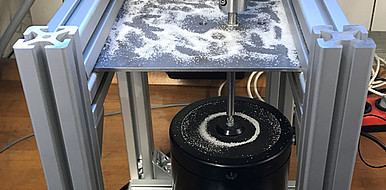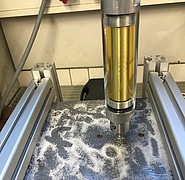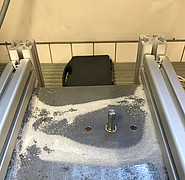A vibration damper as an add-on solution
Uncontrolled vibrations are a frequent problem in technical systems. Whether it be in machines, car bodies or major civil engineering constructions, vibrations are not only a noise nuisance but above all cause material fatigue and wear and tear. The principle of vibration damping is often used in order to minimise these vibrations, for example in a car or in the washing machine.
State of the art
Here, a damping device is attached between two points of the vibrating system or between one point of the system and a fixed point in the surrounding environment. Between these suspension points, there is a cylinder with a hydraulic liquid. A suspension fixed to the system is connected to a piston that can move in the cylinder. The vibrations are dampened by the liquid being pushed to and fro. Often, however, the construction is engineered in a manner that does not allow the application of a damper between suitable points in the system. In many machines or structures, the principle does not work because there is no fixed point against which damping can act.
Technology
Researchers at the KIT Institute of Engineering Mechanics (ITM) have now developed a vibration damper that can be mounted for damping independently of other system components. The damper consists of an attachment with a cavity containing a mass body in a hydraulic liquid. The body is centrally fixed to two disc springs acting against each other. When it is coupled to the vibrating system, the natural frequency of the swingable mass body is lower than that of the system to be dampened and its excitement. In accordance with the physical oscillation laws, the vibrations are not transmitted to the mass body – a dynamically immovable point is created against which damping can act.
Advantages
The advantage is that the attachment can be integrated in constructions as an add-on solution at a later stage. Vibrations in a wide range of frequencies can be dampened in particular. A large number of applications would be feasible: on bridges, wind power plants, or car bodies, for example. Simple geometric modifications allow the damper to be optimally adapted to specific requirements.
Options for companies
KIT is looking for partners to apply the technology in practice.
Your contact person for this offer

Innovation Manager Mobility and Information Karlsruhe Institute of Technology (KIT)
Innovation and Relations Management (IRM) Phone: +49 721 608-28460
Email: birgit.schulze@kit.edu



